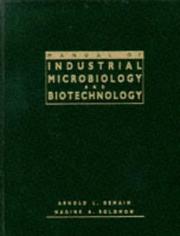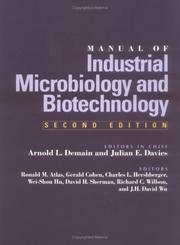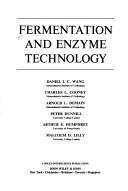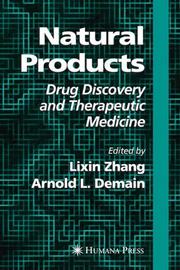| Listing 1 - 10 of 17 | << page >> |
Sort by
|
Article
Year: 2000
Abstract | Keywords | Export | Availability | Bookmark
 Loading...
Loading...Choose an application
- Reference Manager
- EndNote
- RefWorks (Direct export to RefWorks)
METABOLISM --- ANTIBIOSIS --- METABOLISM --- ANTIBIOSIS
Digital
ISBN: 9781592599769 Year: 2005 Publisher: Totowa, NJ Humana Press Inc
Abstract | Keywords | Export | Availability | Bookmark
 Loading...
Loading...Choose an application
- Reference Manager
- EndNote
- RefWorks (Direct export to RefWorks)

ISBN: 0914826735 0914826727 Year: 1986 Publisher: Washington American society of microbiology
Abstract | Keywords | Export | Availability | Bookmark
 Loading...
Loading...Choose an application
- Reference Manager
- EndNote
- RefWorks (Direct export to RefWorks)
Biological techniques --- Biochemical engineering --- Molecular biology --- Biotechnology --- Microbiology --- Technology, Medical --- Industrial microbiology --- Microbiologie industrielle --- Biotechnologie --- Handbooks, manuals, etc --- Guides, manuels, etc --- 663 --- 579.66 --- 66.098 --- Industrial microbiology. Industrial mycology. Zymurgy, fermentation industry. Beverage industry. Stimulant industry --- Industrial and chemical microbiology --- Biological processes. Biotechnology --- Handbooks, manuals, etc. --- 66.098 Biological processes. Biotechnology --- 579.66 Industrial and chemical microbiology --- 663 Industrial microbiology. Industrial mycology. Zymurgy, fermentation industry. Beverage industry. Stimulant industry --- Microorganisms --- Chemical engineering --- Genetic engineering --- Industrial applications --- Microbiology.
Book
Year: 1982 Publisher: Tokyo Japan Antibiotics Research Association
Abstract | Keywords | Export | Availability | Bookmark
 Loading...
Loading...Choose an application
- Reference Manager
- EndNote
- RefWorks (Direct export to RefWorks)
Digital
ISBN: 9781402066740 9789048118939 9789401783200 9781402066733 Year: 2010 Publisher: Dordrecht Springer Netherlands
Abstract | Keywords | Export | Availability | Bookmark
 Loading...
Loading...Choose an application
- Reference Manager
- EndNote
- RefWorks (Direct export to RefWorks)
The protein hydrolysates industry is growing rapidly yet there is no single book that describes the challenges and opportunities for manufacturers and end users, techniques used in manufacturing, characterization and screening of protein hydrolysates, their applications in a wide variety of industries in biotechnology. One of the misconceptions in using protein hydrolysates in fermentations is that the end user believes and uses it as a mere nitrogen source. However, the functionality of the product obtained is not necessarily due to protein hydrolysates alone because it may not be a pure peptide or a combination of peptides and may contain carbohydrates, lipids, micronutrients, etc., present in the raw material used or sometimes the manufacturers deliberately add to the process to bring unique functionality. Only a handful of manufacturers dictate this market that tend to keep manufacturing process proprietary making it harder to understand. This book will close the gap by unfolding information on latest developments.
General biochemistry --- Plant physiology. Plant biophysics --- Botany --- Animal biochemistry --- Nutritionary hygiene. Diet --- Biotechnology --- systematische plantkunde --- biochemie --- voedingsleer --- biotechnologie --- botanie --- planten
Book
Abstract | Keywords | Export | Availability | Bookmark
 Loading...
Loading...Choose an application
- Reference Manager
- EndNote
- RefWorks (Direct export to RefWorks)

ISBN: 1555811280 Year: 1999 Publisher: Washington, D.C. ASM Press
Abstract | Keywords | Export | Availability | Bookmark
 Loading...
Loading...Choose an application
- Reference Manager
- EndNote
- RefWorks (Direct export to RefWorks)
Biological techniques --- Biochemical engineering --- Molecular biology --- Biotechnology --- Micro-organisme --- microorganisms --- Propriété des micro-organismes --- Microbial properties --- Biotechnologie --- Fermentation --- Activité enzymatique --- Enzyme activity --- Génie génétique --- genetic engineering --- Culture de cellule --- Cell culture --- Milieu de culture --- culture media --- Technique de culture --- Culture techniques --- Changement technologique --- technological changes --- 663 --- 579.66 --- 66.098 --- Industrial microbiology. Industrial mycology. Zymurgy, fermentation industry. Beverage industry. Stimulant industry --- Industrial and chemical microbiology --- Biological processes. Biotechnology --- Industrial microbiology --- Basic Sciences. Biotechnology --- Handbooks, manuals, etc. --- Biotechnology (General) --- Biotechnology (General). --- 66.098 Biological processes. Biotechnology --- 579.66 Industrial and chemical microbiology --- 663 Industrial microbiology. Industrial mycology. Zymurgy, fermentation industry. Beverage industry. Stimulant industry --- Microbiology --- Microorganisms --- Chemical engineering --- Genetic engineering --- Handbooks, manuals, etc --- Industrial applications

ISBN: 0471919454 9780471919452 Year: 1979 Publisher: New York, N.Y. John Wiley & Sons
Abstract | Keywords | Export | Availability | Bookmark
 Loading...
Loading...Choose an application
- Reference Manager
- EndNote
- RefWorks (Direct export to RefWorks)
Outlines the fundamental microbiological, biochemical, genetic, and engineering aspects of fermentation, presenting advanced methods of fermentation and control. Covers the isolation of enzymes, especially those found in intracellular contents of microorganisms. Discusses enzyme immobilization and the factors influencing the use of enzymes in reactors.
biotechnologie --- biochemie --- General biochemistry --- Biotechnology --- Fermentation --- Enzymes --- Microbiology --- Chemical Engineering --- Industrial applications --- 663.1 --- microbiologie --- -Fermentation --- Ferments --- Biochemical engineering --- Chemistry --- Industrial microbiology --- Microbiological synthesis --- Leavening agents --- Biocatalysts --- Soluble ferments --- Catalysts --- Proteins --- Enzymology --- Microbiological industries. Science and technique of applied microbiology. Applied mycology --- Fermentation. --- Chemical engineering. --- Enzymes. --- Microbiology. --- Continu cultuur --- Enzymentechnologie --- Micro-organismen --- Industrial applications. --- Continu cultuur. --- Enzymentechnologie. --- Micro-organismen. --- 663.1 Microbiological industries. Science and technique of applied microbiology. Applied mycology --- Industrial enzymology --- enzymen --- Chemical Engineering. --- Applications industrielles --- Basic Sciences. Biotechnology -- Biotechnology (General) --- ALLW. --- Enzymes - Industrial applications
Book
ISBN: 9781555814786 1555814786 Year: 2008 Publisher: Washington (D.C.) : ASM press,
Abstract | Keywords | Export | Availability | Bookmark
 Loading...
Loading...Choose an application
- Reference Manager
- EndNote
- RefWorks (Direct export to RefWorks)
Biomass energy. --- Bioénergie --- Bioénergie

ISBN: 9781588293831 9781592599769 Year: 2005 Publisher: Totowa, NJ Humana Press Inc.
Abstract | Keywords | Export | Availability | Bookmark
 Loading...
Loading...Choose an application
- Reference Manager
- EndNote
- RefWorks (Direct export to RefWorks)
Although the natural product drug discovery programs of the large drug companies are now equaled by programs for the high throughput screening of synthetic compounds generated through combinatorial chemistry, natural compounds still hold great promise to overcome such problems as antibiotic resistance, the emergence of new diseases, the failure to conquer old diseases, and the toxicity of some contemporary medical products. In Natural Products: Drug Discovery and Therapeutic Medicine, a panel of recognized experts and leaders in the field discuss the past successes of natural products as medicines and review future possibilities arising from both conventional and new technologies. High-performance liquid chromatography profiling, combinatorial synthesis, genomics, proteomics, DNA shuffling, bioinformatics, and genetic manipulation all now make it possible to rapidly evaluate the activities of extracts as well as purified components derived from microbes, plants, and marine organisms. The authors apply these methods to new natural product drug discovery, to accessing microbial diversity, to investigating specific groups of products (Chinese herbal drugs, antitumor drugs from microbes and plants, terpenoids, and arsenic compounds), and to exploiting specific sources (the sea, rainforest, and endophytes). These new opportunities show how research and development trends in the pharmaceutical industry can advance to include both synthetic compounds and natural products, and how this paradigm shift can be more productive and efficacious. State-of-the-art and forward looking, Natural Products: Drug Discovery and Therapeutic Medicine will inspire industrial and academic researchers, practitioners, and developers to once again explore natural products as key sources for the many new drugs needed to solve still unmet medical needs.
| Listing 1 - 10 of 17 | << page >> |
Sort by
|

 Search
Search Feedback
Feedback About UniCat
About UniCat  Help
Help News
News